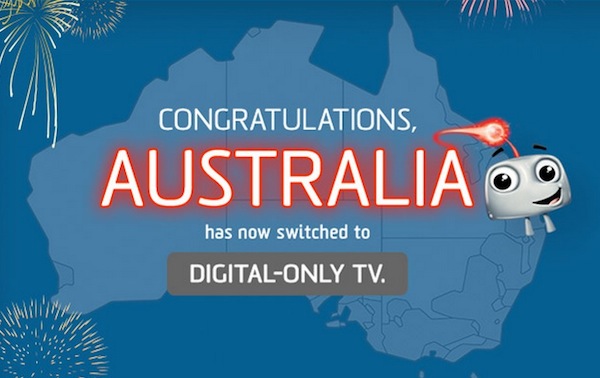This isn't what digital TV was supposed to be

When all the promised benefits of digital TV were being bandied about a decade ago, I don't recall anybody arguing that this major transition was necessary just so Australians could be exposed to an avalanche of television shopping channels — but that's exactly where we are as we begin our first day in nearly 60 years without an analogue TV broadcast being on the air.
Just look at the TV guide, and there they are: Ten-owned SpreeTV, Seven's TV4Me, the TV Shopping Network, Nine Network's eXtra, and its sibling eXtra2.

Each features a titillating program of half-hour infomercials whose migration to digital TV's nether regions has enabled us to enjoy the wonders of the Ninja Mega Kitchen System, the Pearl Hair Remover, the Ab Rocket Twister, and countless other money-sucking contraptions, 24x7.
Thanks to the digital TV switchover, Australians now have access to more 24-hour TV shopping channels than they had to any type of free-to-air (FTA) TV channel for the previous half-century.
That we no longer have to reschedule our working hours so as to be able to stay up to late to view these commercials may be seen by marketers as a significant improvement and a contributor to the new Australian lifestyle. One only hopes that the same infomercials will eventually make their way onto the mainstream digital channels.
Of course, I jest.
There are few who would argue that the transition to digital has been anything but a massive improvement for FTA TV, with its broader range of channels and overall higher broadcast quality. We get more movies for free than ever before — along with more cooking shows, syndicated TV shows, and even the 24-hour ABC News 24.
There are SD and HD channels, although many would say that there have been far too many of the former and far too few of the latter, in part because network owners have chosen to use their precious digital-TV spectrum to increase channel density rather than running a fewer number of HD channels.
Despite the ubiquity of HD-capable TV sets, high-definition broadcasts are still quite limited and by no means the default posture even for local sporting broadcasts. Resolving this disparity will be perhaps the biggest test for the TV industry as it leaves behind its technology-straddling legacy and fully commits to the digital future.
Thanks to the digital TV switchover, Australians now have access to more 24-hour TV shopping channels than they had to any type of free-to-air TV channel for the previous half-century.
And yet, even with the switchoff of digital TV, there are questions about the future of that spectrum. The availability of "digital dividend" spectrum was meant to spur new revenue opportunities for government, from the sale of radio frequency spectrum, while the availability of relatively low-frequency spectrum was positioned to deliver next-generation mobile services that were both faster and more capable than those that went before it.
That was great in theory — Telstra, for one, has been running hot as fervent demand for 4G services helped push it past the 15 million subscriber mark by mid year. Fully 27 percent of Telstra's post-paid customers are said to be using 4G devices.
The company's massive success has come despite its focus on 1800MHz spectrum for 4G rather than the 700MHz digital dividend spectrum — a choice that seemed controversial at the time, but has paid off quite nicely for the company and its bandwidth-hungry customers.
With recent technology trials confirming that bonded LTE channels can deliver up to 300Mbps throughput over the 1800MHz and 2.6GHz spectrum bands, Telstra seems ready to continue growing its business regardless of its investment in 700MHz spectrum, and regardless of the government's earlier attempts to leverage the promise of 4G spectrum access into better terms for its 4G work.
Yet, this leaves us with a bit of a conundrum, particularly since the government failed to sell all of its digital dividend at auction earlier this year, despite significant investments from Telstra, Optus, and TPG. Even a struggling Vodafone could not be convinced to invest, choosing instead to focus its do-or-die 4G network investment around 1800MHz spectrum holdings that it says have allowed it to outperform Telstra and Optus.
That the Australian government is now trying to figure out what to do with digital dividend spectrum, which was expected for years to run hot and heavy, shows the dangers of trying to predict technology trends too far into the future; some would say that the government's extremely long switchover timetable (remember that the US shut off analogue TV over four years ago) forced Australian telcos to find other ways to deliver 4G, rather than just buying into the 700MHz vision.
And yet, as we enter our first year without fuzzy and static-filled analogue TV broadcasts interrupting our TV watching, the new-found availability of that spectrum offers a bit of growing room for the future. Whether this will see new entrants to the market is yet to be seen — investment-hungry TPG currently seems to be the only telecoms aspirant eager to shell out on mobile spectrum to complement its growing network — but the opportunities are there, waiting to be taken if the government can get the right message out.
Perhaps they should advertise the remaining digital dividend spectrum on TV4Me.
What do you think? Is this the digital-TV future you were expecting? How should digital TV be improved? And what will happen with the remaining digital-dividend spectrum?